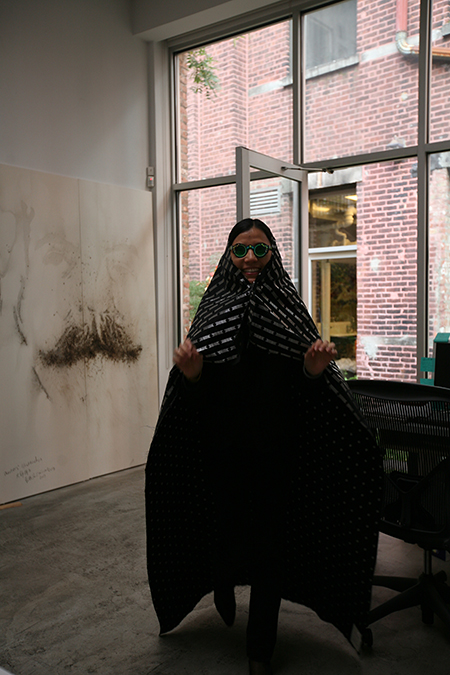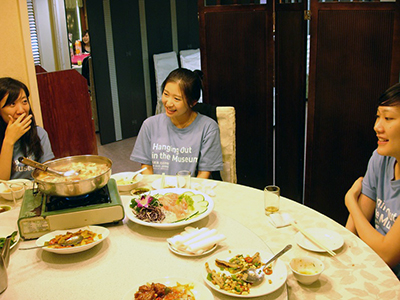Archive for category Cai Studio team
Sojourn to Jutland
Posted by Cai Studio in A Clan of Boats, Cai Studio team, research, travel on October 11, 2012

Cai Guo-Qiang visiting Bulbjerg, Northern Jutland, 2012
Photo by Tine Harden, courtesy Faurschou Foundation
August 21, Cai and Kelly (Project Manager) landed in Aalborg, three weeks before A Clan of Boats opened on September 6. Aalborg is a city in North Jutland, the peninsula that connects Denmark to continental Europe. Jens Faurschou, co-founder of the Faurschou Foundation (formerly Faurschou Gallery), and Tine Harden, photographer and friend of Jens’s since the two were toddlers (their mothers are life-long best friends), joined Cai and Kelly on the trip to offer a Danish point of view, as Cai explored the land of the north, something still foreign to him with his southeast China upbringing.
The relationship between Cai and Denmark began in 1997, when Louisiana Museum of Modern Art in Humlebæk hosted his first solo exhibition in the Western world, Flying Dragons in Heavens. During the installation period, Cai and his family stayed in the boathouse next to the Museum for over a month. There, he was first exposed to the long and brutal winter of Scandinavia, and developed an interest in the Vikings, their culture and history.

Cai Guo-Qiang standing in front of Svinkløv Badehotel, Nothern Jutland, 2012
Photo by Tine Harden, courtesy Faurschou Foundation
Cai decided to explore North Jutland after reading National Park Thy, a book the foundation sent for Cai’s reference while brainstorming the theme of the exhibition, right after the initial site survey in summer 2011. The lyme grass covered sand dunes under the dramatic clouds photographed in the book intrigued Cai, as they did so many artists before him. The foursome first arrived at Svinkløv, a seaside town 2 hours west of Aalborg, close to Thy. The northwestern coast of Jutland, facing the North Sea, is lined with sandy beaches, where it is so windy, that only plants as close to the ground as the sand-loving lyme grass, and certain subshrubs, could withstand the gust. The athletic Jens led the group up and down the dunes, right next to the Svinkløv Badehotel, a small, simple retreat that dates back to early 20th century. “Many couples come here for a romantic getaway,” Jens explained. “That is why apart from us, you see mostly elderly and young pairs.”

Cai Guo-Qiang taking pictures in front of Svinkløv Badehoel, Northern Jutland, 2012 Photo by Tine Harden, courtesy Faurschou Foundation
The traditional dinner served at the hotel restaurant was very relaxing, hearty, and delicate. Jens and Tine monitored their watches, as they wanted to make sure Cai gets to see the sun setting into the North Sea. And indeed, though very cloudy, the dusk turned the sky a coral pink. Many of the diners put down their silverware and napkins, and joined Cai to capture the last ray of summer sun. Even though it was mid-August, the temperature during the day was at an average of 18C/65F, and as the sun went down, the mercury would drop to around 11C/51F.
The next morning, the quartet set off early to Thy, after a simple, healthy Danish breakfast.

Cai Guo-Qiang looking at warship model at Hanstholme Kirke, Northern Jutland, 2012
Photo by Tine Harden, courtesy Faurschou Foundation
Denmark is largely a plain, and the flatness of the landscape makes it easy to see faraway. Vast fields of various crops unfolded from either side of the highway, with one-story houses straight out of fairy tale illustrations dotting the greenery, and rows of wind turbines steadily turning in the background. Horses in capes, cattle, and sheep, all grazed quietly in the scenery. Before entering the district of Thy, Jens drove along the Limfjord, and made a stop to show Cai a generic ancient church in Hanstholme. The church appeared a minimalist structure with no tower and bearing no cross, common in the area when Christianity first arrived in Scandinavia and later under Lutheran influence.
Next, Jens told Cai about the history of the region as the four got back into the car. “During the Second World War, the Germans were afraid that the Alliance would attack from Denmark, so the German troops were stationed here, along the shore.” He took a turn, and the road was no longer paved with asphalt. “I am pretty sure this was paved by the Germans,” he pointed ahead.

Cai Guo-Qiang at Bulbjerg, Northern Jutland, 2012
Photo by Tine Harden, courtesy Faurschou Foundation

Cai Guo-Qiang standing inside of bunker at Bulbjerg, Northern Jutland, 2012
Photo by Tine Harden, courtesy Faurschou Foundation

Cai Guo-Qiang visiting Vorupør Strand, Northern Jutland, 2012
Photo by Tine Harden, courtesy Faurschou Foundation
The foundation scheduled an appointment with Professor Thomas Højrup, an enthnologist at the University of Copenhagen, but resides in Thorup, very close to Thy. There was some time until the meeting, and Jens suggested another quick stop at Vorupør Strand, a beach covered with empty crab shells, making crunch sounds as people walked over. Fishermen took only the claws of large crabs, leaving the body of the crabs to nature, namely flocks of seagulls that had their eyes set on the feast. Tine asked one of the locals, who loaded baskets of claws onto his truck, and found out that only the claws were consumed as a base of stock. In order for Cai to take photos of the birds flying instead of fighting over dead (partial) crabs, Jens, Tine, and Kelly waved their arms as they jumped, mimicking birds flapping their wings, tricking the seagulls to think large predators were close. Unfortunately there was no photo of this silly action!

Cai Guo-Qiang, project manager, Professor Thomas Højrup and Founder of Faurschou Foundation Jens Faurschou at Thorup Strand, Northern Jutland, 2012
Photo by Tine Harden, courtesy Faurschou Foundation

Cai Guo-Qiang and project manager with Professor Thomas Højrup at Thorup Strand, Northern Jutland, 2012
Photo by Tine Harden, courtesy Faurschou Foundation
Professor Højrup can qualify as a Renaissance man. He led the group to the Thorup Strand, a beach only a stone’s throw from his house, and explained in great detail about the tradition of boat building and seafaring. Thorup is an active fishing harbor, but unlike harbors of the rest of the world, here on the west coast of Jutland, they continue the Viking practice of pulling the hulls ashore instead of docking in the sea. This is why the boats are all built with a flat bottom, and the reason the Vikings could very quickly raid and trade along the coastline of Europe.
At lunch time, Professor Højrup welcomed Cai and co to his house to dine with his family of four. The food was simple, fresh, and delicious, and everyone felt satisfied and grateful for the warmth and hospitality. Then, Professor Højrup drove everyone to his boatbuilding workshop at Slettestrand, where he and a small team teach the local young people the trade of traditional boatbuilding by hand. “In the old days, this would be a craft passed down from fathers to sons,” he said. “We want to continue this tradition, as no two boats are built the same – because no two trees are alike. The art of boatbuilding is not something that can be written down into a formula to follow; it is mostly by experience, by touch. Everyone’s method is slightly different.”
The boats the workshop built are not just for display; many of them were on the beach, just a few steps away from the workshop. The workshop also has a showroom, where they explain to the public where they have found the original vessel or wreck, what period they think the boat was from, and how they either repaired or replicated it. What they do is very similar to that of conservators in a museum, especially those in departments that deal with older artifacts; for instance, piecing together an ancient painting that is now in shreds. The shipbuilders (or “skippers”) at Viking Ship Museum in Roskilde often consult Professor Højrup and his students when they have a new project of replicating an existing, historical boat.
Happy Birthday, Hong Hong!
Posted by Cai Studio in Cai Studio team on April 27, 2011
Process
Posted by Cai Studio in Cai Guo-Qiang: Hanging Out in the Museum, Cai Studio team, exhibitions, installation process on February 16, 2010
Here are a few more shots taken back in November when Cai Studio combined forces with Eslite and the Taipei Fine Arts Museum to install Cai Guo-Qiang: Hanging Out in the Museum.
A Reason for Cake
Posted by Cai Studio in Cai Studio team, studio happenings on February 12, 2010
Today we celebrated two February birthdays with a delicious homemade cake. Happy Birthday Bonnie and MeiMei!
Time for Halloween!
Posted by Cai Studio in Cai Studio team, studio happenings on November 3, 2009

Hong Hong Wu in costume. Photo by Bonnie Huie, courtesy Cai Studio.
A Typical Day at the Studio
Posted by Cai Studio in Cai Studio team on November 2, 2009

Photo by Bonnie Huie, courtesy Cai Studio
Snack Time
Posted by Cai Studio in Cai Guo-Qiang: Hanging Out in the Museum, Cai Studio team, travel on October 21, 2009

Photo by Chinyan Wong, courtesy Cai Studio
The Taipei team takes a short break for a delicious meal during a week of preparations for the upcoming show at the Taipei Fine Arts Museum.
A Balancing Act
Posted by Cai Studio in Cai Studio team, installation process on September 24, 2009


Photos by Chinyan Wong, courtesy Cai Studio
Cai working with enginners to figure out how to position the Taihu rocks and pine trees for Cultural Melting Bath at The Taiwain Fine Arts Museum, so the building does not collapse and take out the staff office one floor below
Fire Medicine
Posted by Cai Studio in Cai Studio team, making artwork, media appearances on September 16, 2009
Check out the video feature on VBS.TV’s website.
Philosophy for Life: Intern Report by Jing Liu
Posted by Cai Studio in Cai Studio team, installation process, making artwork on August 5, 2009

Photo by Phoebe Ford
It has been six months since I started interning at Cai Studio. My concentration in college is neither art nor design; instead, I study economics. Due to my curiosity and luck, I was accepted as an intern at the Studio, and it has turned out to be a precious opportunity, allowing me to reconsider my career path and life attitude.
In the past six months I have had a totally new work experience. My projects at the studio include finishing contour drawings for Cai’s gunpowder art works, cutting contour images, assisting Cai to complete gunpowder drawings in the Grucci basement, joyfully chatting with other assistants in Long Island, keeping library books in order, compiling a recent history document, scanning numerous images, carrying Cai’s art works on wooden panels, and translating many reports related to Cai. Most of the work is detail-oriented. My previous internships in the banking industry were associated with numbers and deadline pressure. Contrary to banking, art has taught me to observe every detail and moment in life; it has relaxed my mind and heart. All of a sudden, I have started to observe life, taking time to view sprouting spring grass and ground fallen into the shade of summer trees. I have given up my old habit of rushing through the street without even lifting my eyes to see the direction. What I have learned from Cai Studio is the philosophy for life and the ability to feel happiness. – Jing Liu
眨眼之间,在蔡工作室实习已达六个月之久。自己并不是学艺术出身,而是与艺术相差十万八千里的经济。出于对艺术的好奇,加上偶然的缘分,我来到与银行业完全不一样的蔡工作室。也许这出自于命运的安排,让一个原本浮躁的我,在如此安静的环境中沉淀与思考。
六个月的时间,和这里大大小小的女孩们一起,经历了与我过去完全不同的生活。记得自己给蔡的火药画作过素描底稿,剪切过底稿的形象,和大家一起到长岛Grucci工厂做过火药画,在长岛谈笑风生,整理过图书馆的书籍,编排过资料室里长达20年之久的档案,扫描过无数的照片,搬过蔡厚重的作品,还翻译过很多关于蔡的文章……工作很细,磨人耐心。与以往的银行经验不同,银行与数字打交道,行情变化万千,时时刻刻都在为下一分下一秒担心,很少有时间来享受当下。而艺术却让人放松,仔细地观察生活中的每一个细节、每一处变化。突然之间,我能注意到春天里小草发芽的勃勃生机,夏天里阳光斑驳着树叶婆娑的跳动。时间变得更为静止,我不再背着厚厚的书本,埋头只顾往前冲,而是学会抬头留意身边的的一草一木。学会的是一种生活的哲学和一种静心感受幸福的能力。
Jing Liu joined the studio as an intern in February. Her first task was to cut a huge pile of paperboard stencils before we headed off to Long Island to make a 16-panel gunpowder drawing that will be shown at the Fukuoka Asian Art Triennial next month. This fall, Jing will be a senior at Columbia University.












You must be logged in to post a comment.